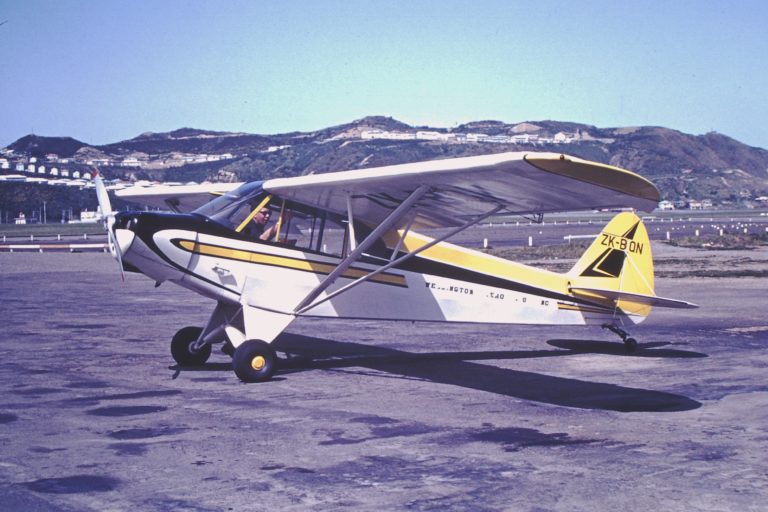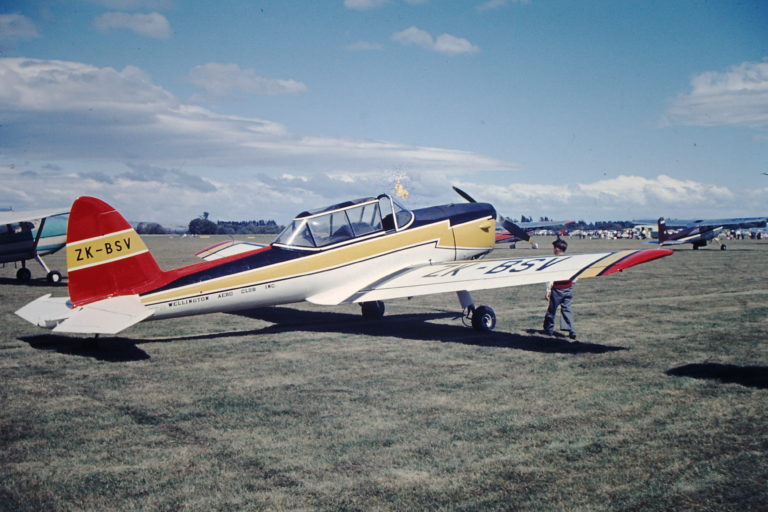|
|
Post by Dave Homewood on Oct 1, 2005 13:29:59 GMT 12
Often in photo captions of old NZ aircraft, you'll see the term used "in the colours of 'such-and-such' aeroclub".
Did the various aeroclubs of the 1930's in NZ have specific colour schemes? I mean they were generally regional, like the Waikato Aeroclub, Hawkes Bay Aeroclub, Auckland Aeroclub, etc. So, did they usually paint their aircraft in the colour of their province? Or did each club have specific colours they stuck to for recognition means, like say one club might paint its fleet of planes in a particular red and sivle scheme?
I just wonder this in terms of working out the various colours of aeroclub planes that were impressed into RNZAF service - their black and white photos often show a silver scheme with an obvious colour applied in stripes, or two-tone or with details on the spats etc. It would be neat for moellers to know what the colours were.
|
|
|
|
Post by Bruce on Oct 1, 2005 21:13:41 GMT 12
Its really difficult to confirm colours off B&W photos! The only aeroclub colours of the 1950s I am aware of was Wellington Aero clubs Cessna 180s which were initally grey with Yellow cheatlines, and a bit later white with Yellow and grey trim. other than that, no idea, although I beleive Waikato aero club moths Prewar were silver with green trim, I cant actually confirm that anywhere.....
|
|
|
|
Post by Dave Homewood on Aug 30, 2018 0:59:33 GMT 12
I am resurrecting this ancient thread because now, with the help of Papers Bast, we can learn some of the colours of the old aeroplanes. These are extracts from news articles:
From the EVENING POST, 20 MARCH 1933
From the PRESS, 2 DECEMBER 1933 (this was ZK-ADE. Later known as NZ574 and ZK-ALG)
From the PRESS, 1 JUNE 1935
|
|
|
|
Post by Dave Homewood on Aug 30, 2018 1:07:44 GMT 12
From the AUCKLAND STAR, 20 OCTOBER 1936
|
|
|
|
Post by Dave Homewood on Aug 30, 2018 1:21:11 GMT 12
From the STRATFORD EVENING POST, 24 SEPTEMBER 1934
|
|
|
|
Post by davidd on Aug 30, 2018 7:45:37 GMT 12
Ted Harvie had a wonderful photograph album, which included photos of pretty well all the active aircraft in New Zealand in the 1930s, although I think he had a bias towards the Aero clubs. Included in the captions were complete notes on the colour scheme worn by that aircraft. Where is this album now? It must be in the hands of somebody (in the AHSNZ?) or an institution. Perhaps some body has photo copied this wonderful album?
David D
|
|
|
|
Post by Dave Homewood on Aug 30, 2018 9:49:59 GMT 12
Hmm, that sounds like a very valuable resource indeed. Perhaps his papers went to the National Archives, or the Walsh Memorial Library?
|
|
|
|
Post by madmax on Aug 30, 2018 12:13:35 GMT 12
Hi Dave, While I'm unable to be specific re "club colours" pre WW11, Wellington Aero Club (WAC) did use Wellington provincial colours with the addition of red on at least two of their aircraft prior to 1939, those were the Miles Hawk (ZK-AEQ) which you elude to and their second Waco ZK-ADE. Post war, between 1946 and 1958, WAC used yellow and black colours on five of their DH82s although a standard scheme was never adopted, also Cessna 180 ZK-BKG was painted grey with yellow and black trim but later repainted two-tone green to match its second C180 ZK-BUS. As I recall several other clubs appeared to semi-adopt Provincial colours, HB&EC Aero Club Tigers mostly had blue lightening flashes on their fuselage sides as did their two Whitney Straights AJZ and AXD and many Canterbury Aero Club aircraft including Miles Hawks ZK-ATD and ATE had red upper fuselages as did their Messenger ZK-ATT. The practice of using provincial colours seemed to die-out with the arrival of Piper Cubs trainers in their predominantly red and white colours. One exception appears to have been WAC which in the sixties painted Chipmunk ZK-BSV and PA18 ZK-BQN in Wellingtons yellow and black colours.   Cheers Madmax |
|
|
|
Post by davidd on Aug 30, 2018 12:40:57 GMT 12
To add to madmax's list (above) the Canterbury AC also had Dragonfly AFB in the silver scheme with bright red upper fuselage, upper engine nacelles (I think) and a red band on fin with registration letters thereon, although originally it flew for the Club for a while in the remains of its Air Travel scheme (orange fuselage, silver flying surfaces). Their short-lived Piper Comanche (BOO) as well as their Apache (BWJ) were in standard Piper red and white schemes, although I think the latter had two versions at different times. Their Tripacers of the late 1950s and 60s also had Piper factory red/cream schemes. The pre-war GA Monospar Jubilee (AET) had a factory scheme of yellow and black originally (on arrival from Australia), but later apparently adopted red and silver. All their Tigers had schemes similar to the Dragonfly, Messenger and Magisters (Hawk Trainers). Their factory-new Citabria (CRT) arrived in a striking red and white sunburst scheme. Their Austers were a mixed bunch so far as colour schemes went, although these often seemed to incorporate a lot of silver and red. Now that I have drained my memory banks I will take a long rest.
David D
|
|
|
|
Post by baz62 on Aug 31, 2018 8:31:28 GMT 12
Yes the Austers with CAC all arrived in the standard factory overall silver with red anti glare panel red registration on wings and fuselage all finished off with a red pinstripe flown the fuselage. Oh and Aiglet written on the tail. I think the wheel hub caps were also red. The club had 4 of them (BBT BBZ BCK and BCQ) but don't know if all of them had red markings or if some had blue (the other option). In the 60s after fabric replacement the remaining Austers (BBT crashed after 1 year) were painted in the same red and white scheme as the Cubs on strength. Even down to the Piper chevron on the tail.
|
|
|
|
Post by johnnyfalcon on Aug 31, 2018 17:45:46 GMT 12
About 99% of Canterbury A.C. current fleet is red and black (over white). Not sure why...
|
|
|
|
Post by flyinkiwi on Sept 3, 2018 8:39:01 GMT 12
I asked Mike Cumming, a life member and former Patron of Waikato Aero Club about Club colour schemes and this was his response:
The problem with the club scrapbook is that all of the photos of that era (even into the 60s) are black and white.
|
|
|
|
Post by thomarse on Jan 31, 2023 15:10:23 GMT 12
One exception appears to have been WAC which in the sixties painted Chipmunk ZK-BSV and PA18 ZK-BQN in Wellingtons yellow and black colours. Breathing life back into an old thread, I seem to recall that Wellington's C172 BWW was yellow, black and white too |
|
|
|
Post by Deleted on Feb 1, 2023 12:08:33 GMT 12
|
|
|
|
Post by madmax on Feb 1, 2023 13:18:19 GMT 12
I think BWW was initially in a polished metal with red trim scheme prior to a repaint in WAC colours
|
|
|
|
Post by Dave Homewood on Mar 17, 2023 12:13:23 GMT 12
An interesting snippet mentioned in a Herald article on the death of Squadron Leader Dave Allan, dated the 13th of March 1940, says, "Flying his beloved orange-coloured Moth, ZK-AAU..." So obviously ZK-AAU was orange (perhaps with silver wings?). Here is a MOTAT photo of Dave Allan in ZK-AAU, from here:  |
|
|
|
Post by davidd on Mar 17, 2023 15:38:03 GMT 12
Why is the Moth in sunlight, while the sky full of clouds, and the ground and sea are as dull as ditchwater?
|
|
|
|
Post by baz62 on Mar 17, 2023 16:11:13 GMT 12
Why is the Moth in sunlight, while the sky full of clouds, and the ground and sea are as dull as ditchwater? If you look at the clouds I think you can see there is a clear part(being black and white the blue looks dull grey), so most likely the cloud shadow is on the water but the sun is shining brightly on the airraft (and the ground below out of shot. |
|
|
|
Post by davidd on Mar 17, 2023 16:41:22 GMT 12
Looks like the sun is somewhere BEHIND the photographer judging by sharp shadow on lower wing of the Moth, including lighted tip of starboard lower plane - what do you reckon?
|
|
|
|
Post by The Red Baron on Mar 17, 2023 21:08:26 GMT 12
The Moth has been hand coloured or retouched as they used to do on photos of that era.Theres a lot of photograhic noise in the photo and none on the Moth,which suggests it been hand retouched.The Moth was probably quite blurred in the original print,retouching covers it up.Most photograhic companies and newspapers employed ladies to hand colour and redo photos back then.Cameras and film were also nothing as sophisticated as they are today back in the 'olden days' either.... link |
|



